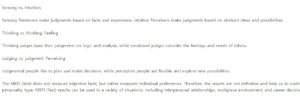The MBTI personality type test is in vogue. Learn what the MBTI test is, what the 16 types are, and how to use the MBTI test personality type test.
What is the MBTI test by personality type?
MBTI (Test), short for Myers-Briggs Type Indicator (Test), is a personality assessment tool developed by personality psychologists Carl Jung and Isabel Briggs Myers. The MBTI (Test) is used as a tool to understand and explain individual personality, personality and behavioral aspects.
The MBTI (Test) is based on four dimensions of the way individuals primarily use perception and decision-making. These four dimensions are:
Extraversion vs. Extraversion Introversion
Extroverts like to be stimulated from the outside and like to work and talk with people. Introverts, on the other hand, are quiet and inactive, and recharge their energy when alone.
Sensing vs. Intuition
Sensory Perceivers make judgments based on facts and experience; intuitive Perceivers make judgments based on abstract ideas and possibilities.
Thinking vs. thinking. Feeling
Thinking judges base their judgments on logic and analysis, while emotional judges consider the feelings and needs of others.
Judging vs. judgment. Perceiving
Judgmental people like to plan and make decisions, while perceptive people are flexible and explore new possibilities.
The MBTI (Test) does not measure objective facts, but rather measures individual preferences. Therefore, the results are not definitive and help us to understand a person’s personality type. MBTI (Test) results can be used in a variety of situations, including interpersonal relationships, workplace environment, and career decision-making.

16 types of MBTI
MBTI (Test) results are displayed as a four-letter alphabetic code representing an individual’s personality type. Each digit represents a person’s preference in that dimension, representing the following 16 personality types:
ISTJ: The Thorough and Quiet Manager
ISFJ: patient and kind guardian
INFJ: Visionary Advisor
INTJ: Strategic Scientist
ISTP: Technicians with great coping skills
ISFP: A sensitive artist with an artistic flair.
INFP: Mediator who seeks ideals
INTP: Logical Thinker
ESTP: Free-spirited Challenger
ESFP: Active and Fun Entertainer
ENFP: Innovators with passion and creativity
ENTP: witty and ingenious inventor
ESTJ: organizer with a sense of reality
ESFJ: The active and sociable diplomat
ENFJ: Kind and outgoing teacher
ENTJ: Leader with leadership and passion
By identifying and understanding individual personality types using MBTI (Test) results, you can identify your strengths and weaknesses and promote personal growth and development. In addition, by identifying the personality type of others, you can promote smooth communication and cooperation in interpersonal relationships and work environments. However, since the MBTI (Test) evaluates a person’s personality in a way that has not been scientifically proven, using the results as a perfect diagnosis or predictive tool should be avoided.
How to use the MBTI Inspection Test?
The MBTI (Test) is usefully used to indicate an individual’s personality type. You can use it to promote personal growth and development in many aspects, including career choices, academic planning, interpersonal relationships, and marriage.
MBTI (Test) can be used for team building or personnel management, especially in the workplace. When building a team, organizing people of different personality types to work harmoniously will help you work efficiently and achieve your goals. In addition, in personnel management, personal growth and development can be promoted through measures such as capacity building or job change according to the individual’s personality type.
However, personality type classification using the MBTI (Test) is not an academically recognized subject, and has some limitations and errors like other methods of assessing individual personality. Therefore, it is better to avoid using MBTI (Test) results as a perfect diagnosis or prediction tool, and to use them to understand individual personality types and promote personal growth and development.
One of the ways to promote personal growth and development using MBTI (Test) results is to identify and utilize your strengths and weaknesses. Each type of MBTI (Test) has its own unique strengths and weaknesses, so you can understand them and use them to strengthen your individual capabilities.
There is also a way to develop interpersonal relationships using MBTI (Test) results. In the MBTI (Test), since each person’s personality type has a different interpersonal relationship style, it is important to understand the other person’s personality type and choose an appropriate coping method. This allows you to build a smooth interpersonal relationship in situations of dialogue, cooperation, and disagreement.
Lastly, it is also helpful to choose a direction that fits your personality type in job selection or study planning by using the MBTI (Test) results. In the MBTI (Test), each personality type has a different preferred career field or academic tendency, so it is important to understand this and choose a career or academic field that matches your interests. This can increase a person’s job fitness or academic achievement.